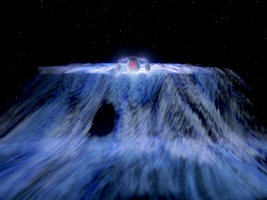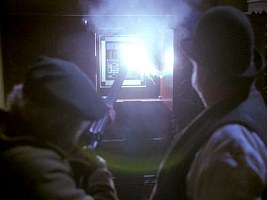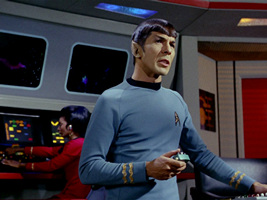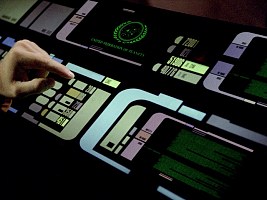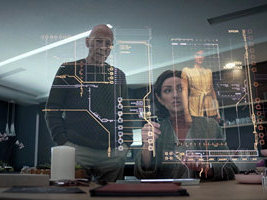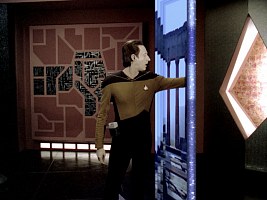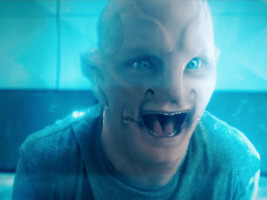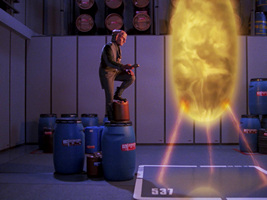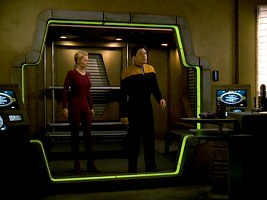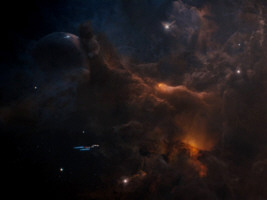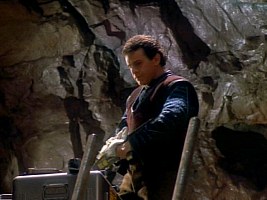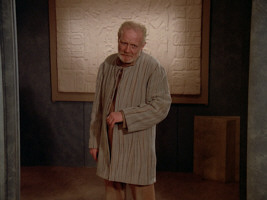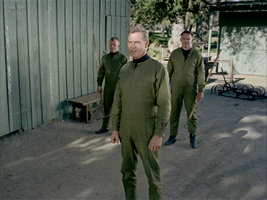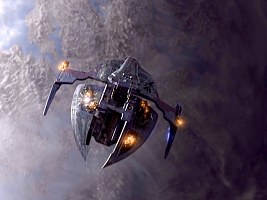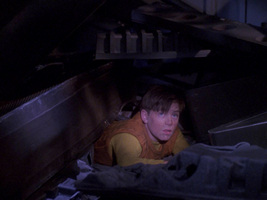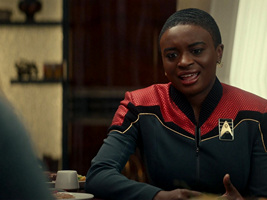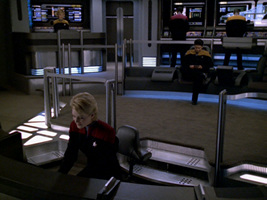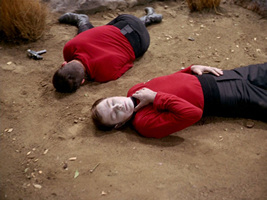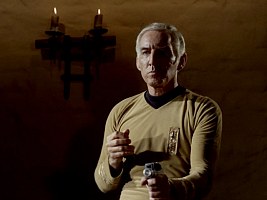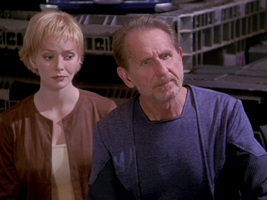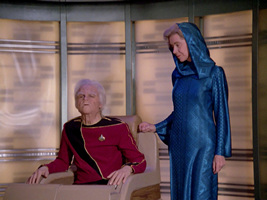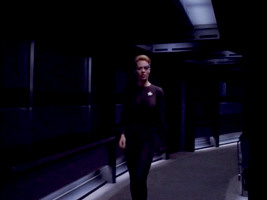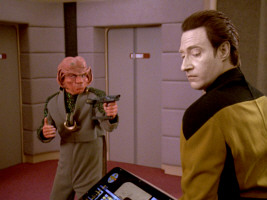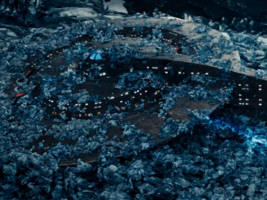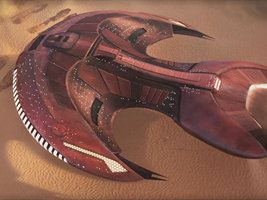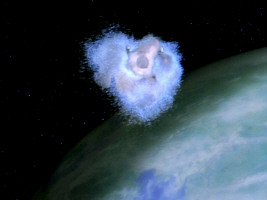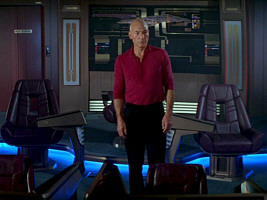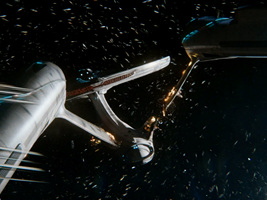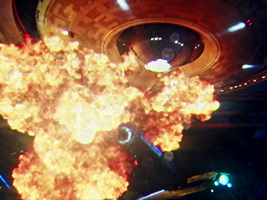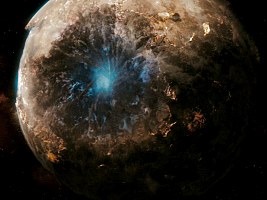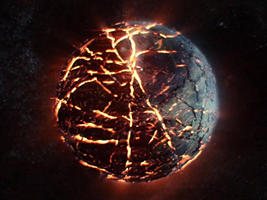Star Trek Clichés
Technical StandardsSettingsStock CharactersPlot Devices
Star Trek, like any fiction, is not quite like the real world. Some oddities do not really qualify as inconsistencies, and it isn't always helpful or necessary to explain them away. Still they are typical of Star Trek, especially as they occur frequently and become clichés.
Technical Standards
Blinkies
It seems every technical device in Star Trek since TNG incorporates a flashing light. There is nothing wrong with an LED (or a future equivalent of an LED) to indicate the operation mode or status of a device, especially if it is a hand-held scanner or jammer. But the prop designers go too far with this habit and build in blinking LEDs just everywhere even if there is absolutely no need for such an indicator. This culminates in the Doctor's blinking golf balls in VOY: "Drive".
Catastrophic failure of new technology
It seems that whenever revolutionary experiments are conducted or novel technology is tested for the first time, it very likely winds up as a (near) disaster, and the innovation has to be declared a total failure. The classic example is the catastrophic field test of Daystrom's multitronic computer M-5 in TOS: "The Ultimate Computer".
The list of new technology that utterly fails grows steadily especially during TNG. We may discount TNG: "Where No Man Has Gone Before" because here it is due to the Traveler's interference that the warp drive modification goes awry. But the temporal ruptures of TNG: "We'll Always Have Paris" are a clear example of an irresponsible experiment with incalculable consequences, as are the genetic modifications on humans in TNG: "Unnatural Selection". We may also include TNG: "Evolution" because it was in no way intended that the nanites should develop a conscience of their own and put the ship at risk. TNG: "A Matter of Perspective" is a pleasant exception because here the disaster happens because of blatant carelessness (Apgar fires at Riker but the beam is reflected from the transporter confinement beam and hits the radiation generator), not because the technology is genuinely flawed. Wesley's risky experiment almost costs his mother's life in TNG: "Remember Me". TNG: "New Ground" is another classic case because the circumstances are much the same as in "The Ultimate Computer". Here, it is a new drive technology that is deemed to revolutionize space travel - if only it would work as intended. TNG: "The Next Phase" shows that the Romulans are not really more successful in testing innovative technology (I don't assume the whole accident with the phase cloak was fabricated, just that the cloaked Romulan used the opportunity to sabotage the Enterprise). Not only the Romulans, but also the Federation has made bad experiences with phase cloak, see TNG: "The Pegasus". TNG: "The Quality of Life" even has two new technologies causing trouble: The particle fountain goes berserk, and the exocomps don't function as they were programmed because they become self-aware. The latter is rather a positive aspect; still the episode fits into the overall negative image of new technology in TNG.
The episode TNG: "Suspicions" is one of the few examples from TNG that new technology, here the metaphasic shields, may actually work. On the other hand, it is just another cliché that technologies initially deemed impossible, useless or dangerous works flawlessly when needed. The other Star Trek series have a less definite tendency to let new technology fail. Most prominently this questionable "tradition" from TNG is continued in VOY: "Threshold" (okay, we should better stay silent about this one) and in VOY: "The Omega Directive".
 The fate of the spore drive prototype ship USS Glenn, whose crew is killed by a tardigrade in a gruesome way in DIS: "Context is for Kings", is another prime example of the cliché. The decision to ultimately abandon and even deny the existence of this technology has other reasons, however. The series also adds Section 31's AI named "Control" to the list, which is swept under the rug likewise.
The fate of the spore drive prototype ship USS Glenn, whose crew is killed by a tardigrade in a gruesome way in DIS: "Context is for Kings", is another prime example of the cliché. The decision to ultimately abandon and even deny the existence of this technology has other reasons, however. The series also adds Section 31's AI named "Control" to the list, which is swept under the rug likewise.
 The automated Texas-class ships turn out to be a catastrophic failure in LOW: "The Stars at Night" because they use an unstable code according to Ensign Rutherford.
The automated Texas-class ships turn out to be a catastrophic failure in LOW: "The Stars at Night" because they use an unstable code according to Ensign Rutherford.
The fleet formation technology in PIC: "Vox" that facilitates the cataclysmic mass assimilation of Starfleet by the Borg is another reiteration of the classic cliché.
 The fate of the holodeck after SNW: "A Space Adventure Hour" is an unintentional parody of the trope. Scotty deems the technology unsafe and recommends to abandon it for now (through the fourth wall, to save continuity). The technology would resurface decades later, with exactly the same capabilities as the prototype and exactly the same deficiencies!
The fate of the holodeck after SNW: "A Space Adventure Hour" is an unintentional parody of the trope. Scotty deems the technology unsafe and recommends to abandon it for now (through the fourth wall, to save continuity). The technology would resurface decades later, with exactly the same capabilities as the prototype and exactly the same deficiencies!
Holodeck failures
Not only experimental technology, but just as well every-day devices suffer from severe malfunctions more often than we should expect. The by far most harmful one is the holodeck. In every few episodes that we see the holodeck, crew members are trapped inside or the safety procedures go offline. Preferably both malfunctions happen simultaneously. We may want to excuse this apparent tendency, considering that Star Trek episodes always focus on unusual occurrences, rather than showing the boring normal operation of a technology. Still, the statistics are odd if the holodeck becomes dangerous and possibly lethal every few months on a starship for whatever reason, in which case it would be doubtful that the crew and family members could use it for recreation.
The reasons for the malfunctions are very diverse though. In TNG: "The Big Goodbye" (the mother of all holodeck failures) it is an inadvertent alien influence (the scan by the Jarada ship). Something remotely comparable happens when alien beings from subspace instinctively take control of Voyager's holodeck in VOY: "Heroes and Demons" and once again in VOY: "Bride of Chaotica!". Intentional alien manipulation is the cause for the holodeck becoming hazardous in VOY: "Alter Ego". In VOY: "Worst Case Scenario" Seska's tampering traps the users in a deadly situation. The reason for the failure lies on the holodeck itself and more precisely in a too complex character in TNG: "Elementary, Dear Data" and "Ship in a Bottle". In a vaguely similar fashion the Doctor, as a part of a holographic program, is trapped in the holodeck in VOY: "Projections". In TNG: "A Fistful of Datas" it is Data's experiment of connecting his brain to the Enterprise's memory that lets the holodeck run out of control, although we should believe that safety protocols would rather kick in in case of a memory overflow than go offline. Something comparable happens in DS9: "Our Man Bashir" when the transporter patterns of crew members are stored in the holographic matrix.
The sad culmination of stupid accidental holodeck failures is in VOY: "Spirit Folk" where an allegedly safe holographic bullet hits the control panel and turns the safety protocols off. An interesting variant can be seen in TNG: "A Matter of Perspective". Here the holodeck creates a device, a Krieger wave generator, that becomes dangerous only through interaction with the outside world.
Occurrences of unsafe holodecks that we should discount are VOY: "The Killing Game" and VOY: "Flesh and Blood" because here the whole system has been laid out by the Hirogen to be dangerous. Likewise, in VOY: "Night" Seven intentionally disables the safety protocols although we shouldn't expect that to be so easy (much less that it would work on a mostly powerless, frozen holodeck). The same applies to VOY: "Extreme Risk" where B'Elanna turns off the protocols for the authentic experience of the risks of orbital skydiving and to "First Contact" where Picard is successful in killing the Borg with a holographic submachine gun. Curiously, in VOY: "Twisted" the whole ship gets bent and twisted, but of all places the holodeck is unaffected and serves as a shelter while the program is still running.
 The Lower Decks episode "Terminal Provocations" is a parody on the classic holodeck failure cliché. A bit like Data's antagonist Moriarty, the holographic helper "Badgey" becomes a villain and it is not possible to simply shut down the holodeck. The storyline with Badgey is picked up again in "No Small Parts" and in "A Few Badgeys More".
The Lower Decks episode "Terminal Provocations" is a parody on the classic holodeck failure cliché. A bit like Data's antagonist Moriarty, the holographic helper "Badgey" becomes a villain and it is not possible to simply shut down the holodeck. The storyline with Badgey is picked up again in "No Small Parts" and in "A Few Badgeys More".
 In DIS: "Su'Kal", the holographic environment on the Khi'eth can't be shut down. But rather than the malfunctions, it is implausible that the holodeck (as well as life support and other systems) has been up and running for as long as 125 years.
In DIS: "Su'Kal", the holographic environment on the Khi'eth can't be shut down. But rather than the malfunctions, it is implausible that the holodeck (as well as life support and other systems) has been up and running for as long as 125 years.
 The crew is trapped inside the holodeck in PRO: "Ghost in the Machine". As usual, the safety protocols are inactive too. However, the reason for all this is not a random malfunction but deliberate manipulation to keep the crew busy while the Living Construct is taking over the Protostar. So this animated episode boldly defies the cliché.
The crew is trapped inside the holodeck in PRO: "Ghost in the Machine". As usual, the safety protocols are inactive too. However, the reason for all this is not a random malfunction but deliberate manipulation to keep the crew busy while the Living Construct is taking over the Protostar. So this animated episode boldly defies the cliché.
Exact countdown to failure
In the real world, there are more than sufficient safety margins for anything constructed by engineers. These margins have to exist because of the inevitable measurement uncertainties and manufacturing tolerances that allow only a coarse extrapolation of the actual failure conditions, and also for reasons of product warranty and safety standards. Scotty would definitely confirm that. He himself tells Geordi that he always accordingly modified the figures for the captain and for the technical manuals (TNG: "Relics").
Still, in Star Trek there are almost customarily absolute maximum ratings that denote a precise point of destruction or otherwise catastrophic malfunction of a device, as if the real ship or phaser behaved exactly like a simulation. For instance, there are usually definite figures for failure of shields, structural integrity or life support or for the explosion of engines or power cells. Spock and Data occasionally even go as far as giving a time to failure with a precision of less than a second! One particularly bad example is in TOS: "That Which Survives", where Spock is obsessed with the idea that the damaged engines will explode in exactly "14.87 minutes" instead of Scotty's estimation of 15 minutes. In "Star Trek Generations", the officer played by Tim Russ reports "45 seconds to structural collapse". In TNG: "Hollow Pursuits", Data reckons that the time to structural failure will be precisely "15 minutes 40 seconds". In DS9: "Babel", Quark announces the explosion of Jaheel's ship to the second. In VOY: "Year of Hell", the computer counts down the seconds to the structural collapse on deck 5, and it occurs exactly at "zero". The Doctor takes the countdown at face value. He seals off deck 5 as the computer voice says "one", although he sees crew members running towards the bulkhead he closes.
A laudable exception to the cliché can be found in TNG: "Heart of Glory". On the damaged Talarian ship Batris, Riker asks: "How long before this hull ruptures?" Geordi replies, "It's impossible to be exact. I'd say five minutes. Probably less." On some occasions reasonable safety margins and fabrication tolerances are taken into account. Another positive example in this vein is DS9: "Paradise", where Dax tells Kira that if the builders had a good day, the runabout wouldn't break apart when trying to tractor another runabout at maximum warp. They did have a good day.
Everything's ok
"All systems normal" - A statement like this handles all those tidy wrap-ups on TNG and VOY where the ship has been put through hell, and then after the conflict, everything, no matter how bad, is perfectly fine without the help of a temporal anomaly. A few examples include TNG: "Force of Nature" where the ship exceeds structural tolerance by 120% and almost gets torn apart, but after the waves stop, all systems are back to normal. In TNG: "Genesis", after the cure is found, instantly everything is fine! Dr. Crusher, who needed reconstructive surgery, is back to duty, the "destroyed power transfer grid" is working fine, the damaged main computer seems to be working again, and no one's hurt - not to mention the psychological side effects of the temporary transformation of the crew. At the end of VOY: "The Killing Game, Part II", after bloody fighting, damage to the ship all over, and practically all decks ravaged, everything still seems to be running fine. Actually, Voyager is always in perfect shape at the beginning of any episode, although there is no spacedock or other facility for repairs and the resources are limited - a clear example of a reset button that was deemed necessary to be able to use always the same stock footage and to avoid permanent damage to the sets.
The third season of Star Trek Enterprise deserves to mentioned because it overcomes the cliché. While on a military mission in Xindi territory, Enterprise NX-01 gets attacked repeatedly, with only very limited resources for repairs, and looks increasingly battered.
(compiled by Derek)
Power from life support
"Re-route power from life support to the weapons/engines!" - This seems like a typical melodramatic ploy to get people thinking the situation is desperate, such as in VOY: "Hunters", VOY: "Demon", VOY: "One", VOY: "Dark Frontier" or "Star Trek Nemesis". But since when is the air circulation system such an abundant power tap? Agreed, power may be short during a battle or when the supply is exhausted for other reasons, but the little bit that life support could provide really wouldn't help a lot. Moreover, there should be other systems that are not being needed and that are already down or could be shut down. As systems on board the ship get damaged or become inoperable, what happens to their power? They would not keep expending power. Power which be could diverted to whatever is needed. For example, the Enterprise needs power for warp, but they aren't using their phasers. The power allocated to the weapons should be available for the engines, or vice versa.
In VOY: "Revulsion" the isomorph (the holographic person who has killed his organic crewmates) states that life support takes up as much as 59.2% of the ship's power - "just to keep them breathing, warm, and comfortable." By no means this figure can be authentic, even if we include the holodeck and replicator, unless the engines are off. We should simply not trust the mad hologram.
Unlike it happens a couple of times especially in TOS and TNG, once life support goes offline during a battle or is intentionally shut down, it certainly would take more than just a couple of minutes until everyone suffocates or freezes to death. Yet, only few Star Trek episodes are realistic in this respect. In DS9: "Civil Defense", for instance, Jadzia mentions that there are as many as 12 hours to get the system to work again.
PIC: "No Win Scenario" is a more recent and arguably one of the most notable examples of the trope, as the Titan needs every bit of the remaining energy for propulsion and Captain Riker eventually orders to shut down life support.
(suggested by Derek)
Cryptic computer interfaces
User interfaces in the real world are continuously designed to provide more ease of use, be it for personal computers or for commercial, medical, scientific or military applications. In contrast, it appears that the computer users of the 24th century need to memorize cryptic numerical codes to understand and operate Starfleet's equipment. Aside from library information, which is the only data in plain English, the monitors on the Enterprise-D usually show letter and number combinations without an apparent meaning. If useful data were being displayed, it would at least require a structure like "category: variable = value" and the usage of units to make sense, but something like that is almost never recognizable.
Also, there are no keyboards that would allow alphanumeric entry. The rationale for the absence of the keyboard is the existence of a highly reliable voice interface. It is evident that it is much faster to take advantage of vocal entry than to type in long textual requests, while the key interface may be still beneficial for simple commands like "enter", "next" or "cancel".
Yet, why is the entire display on most monitors cryptic most of the time? Perhaps the crucial information on the ship's operation is not meant to be visible to everyone, but just to authorized people working at that very station, and obviously most stations remain unattended most of the time. Perhaps the seemingly random numbers are even sort of a 24th century screensaver. But even when some crew member (not only Data) is working on a terminal, they pretend that they can make sense of the cryptic display. So do they really have to learn a code? It almost seems so, especially since Starfleet officers never have any trouble understanding even an alien computer interface, not only those of familiar races like the Klingons. It seems that most known aliens of a comparable technological level have settled on a universally comprehensible standard for their computer interfaces. Only the letters and symbols are different. Starfleet officers only have observable difficulties operating ancient technology (Kirk's attempt to drive a car in TOS: "A Piece of the Action") or extremely advanced interfaces (Data needs some time to figure out how the Iconian computer works in TNG: "Contagion"). It appears that 21st century humans are just too stupid to understand the amazing logic that lies in the humanoid-machine interfaces of the 24thc century.
 In "Section 31", Alpha Team reactivates an alien garbage scow and launches it into space, all apparently with ease. Then, however, Quasi has trouble figuring out which button would open the cargo bay and which one would activate the self-destruct...
In "Section 31", Alpha Team reactivates an alien garbage scow and launches it into space, all apparently with ease. Then, however, Quasi has trouble figuring out which button would open the cargo bay and which one would activate the self-destruct...
Transparent computer interfaces
 Whereas holographic displays showed up only occasionally in previous series, Star Trek Discovery and Star Trek Picard use them consistently for all kinds of purposes. Overall, it is laudable that the new Star Trek series display information in a less cryptic fashion than it was in classic Star Trek. The problem now is that the sheer amount of information on displays is usually very confusing, especially since everything is essentially monochromatic (preferably all-blue with some traces of red). In addition, displays are usually transparent now, which makes everything additionally hard to read or recognize. While it may seem cool to be able to show the actor's face through the transparent display, it doesn't make sense as a real-life technology.
Whereas holographic displays showed up only occasionally in previous series, Star Trek Discovery and Star Trek Picard use them consistently for all kinds of purposes. Overall, it is laudable that the new Star Trek series display information in a less cryptic fashion than it was in classic Star Trek. The problem now is that the sheer amount of information on displays is usually very confusing, especially since everything is essentially monochromatic (preferably all-blue with some traces of red). In addition, displays are usually transparent now, which makes everything additionally hard to read or recognize. While it may seem cool to be able to show the actor's face through the transparent display, it doesn't make sense as a real-life technology.
Functional ancient technology
It is a recurring setting in Star Trek that the crew finds traces of a long-dead civilization. This alone is not a surprise, after all that's what they are supposed to do on a ship of exploration. Still, there is one frequent cliché: Most advanced civilizations, even if they were completely destroyed in a war or global disaster, have left behind technology that is still operational and powered. Sometimes there are even survivors.
There are countless examples, such as TOS: "What are Little Girls Made of", "Miri", "The Return of the Archons", "The City on the Edge of Forever", "The Apple", "I, Mudd", "Return to Tomorrow", "The Paradise Syndrome", "Spock's Brain", "For the World is Hollow and I Have Touched the Sky", "That Which Survives", "Turnabout Intruder", TNG: "The Last Outpost", "The Arsenal of Freedom", "Contagion", "Booby Trap", "Final Mission", "The Inner Light", "Gambit", "Masks", DS9: "Dramatis Personae", "To the Death", VOY: "The Thaw", "Dragon's Teeth", "Memorial", ENT: "Dead Stop", "Kir'Shara" and PIC: "Broken Pieces".
It is interesting to notice that the idea is used less frequently since the time of TOS when it showed up massively. It may be possible to design self-sustaining technology, especially if it is meant to survive that long. Still, it is not plausible that it apparently always works as intended for millennia. We may include TNG: "The Chase" as the ultimate example of how knowledge of a civilization may be preserved in the form of inherited DNA segments.
 After it has been a minor issue in 1990's Trek, Discovery adds many new items to the list of functional ancient technology: the Klingon Beacon of Kahless (DIS: "The Vulcan Hello"), the Sphere (DIS: "An Obol for Charon") and the sleeper ship (DIS: "Choose to Live"). Although it has been running for "only" a century, the holographic environment on the Khi'eth (DIS: "Sukal") belongs into this category too. And finally, we have nearly everything that the ancient puzzle in season 5 is composed of. On the 800-year-old Romulan ship in DIS: "Red Directive", many of the systems are still operational and have power. In the next episode "Under the Twin Moons", the Promellian EM field and their drones are as effective as ever after thousands of years. DIS: "Whistlespeak" is both a confirmation of the cliché and an exception. The water tower initially found in the episode has been running on Halem'no for 800 years, but four more ones stopped working long ago. In DIS: "Lagrange Point", the structure remains intact inside the accretion disks of two black holes for 800 years and can be powered up with no problems. And finally, in "Life Itself", Burnham finds herself in a perfectly maintained environment that quite possibly predates the creation of our universe.
After it has been a minor issue in 1990's Trek, Discovery adds many new items to the list of functional ancient technology: the Klingon Beacon of Kahless (DIS: "The Vulcan Hello"), the Sphere (DIS: "An Obol for Charon") and the sleeper ship (DIS: "Choose to Live"). Although it has been running for "only" a century, the holographic environment on the Khi'eth (DIS: "Sukal") belongs into this category too. And finally, we have nearly everything that the ancient puzzle in season 5 is composed of. On the 800-year-old Romulan ship in DIS: "Red Directive", many of the systems are still operational and have power. In the next episode "Under the Twin Moons", the Promellian EM field and their drones are as effective as ever after thousands of years. DIS: "Whistlespeak" is both a confirmation of the cliché and an exception. The water tower initially found in the episode has been running on Halem'no for 800 years, but four more ones stopped working long ago. In DIS: "Lagrange Point", the structure remains intact inside the accretion disks of two black holes for 800 years and can be powered up with no problems. And finally, in "Life Itself", Burnham finds herself in a perfectly maintained environment that quite possibly predates the creation of our universe.
In Strange New Worlds, "Children of the Comet" shows a comet with technology that may be billions of years old. The eternal prison in SNW: "Through the Lens of Time" is a textbook example of the trope.
"Section 31" adds the garbage scow that has been abandoned for who knows how long but is ready to go to high warp, with fully operational shields, after a few minor repairs. Even the asymptote coil, a valuable component that everyone thought had been scavenged, is still available (Sahar secured it because of the mole in his team).
 Although or just because it is meant to be a parody, the activation of the ancient artifact in LOW: "Strange Energies" is a prime example of the cliché. Also on Lower Decks, the starships of the Areore are immediately spaceworthy after being mothballed for millennia in "A Mathematically Perfect Redemption". The massive Orion ship in "Old Friends, New Planet" cannot be made operational and has to be towed to break through Locarno's Trynar shield. The old medical ship in "Dos Cerritos", on the other hand, needs just a few small repairs to lift off again.
Although or just because it is meant to be a parody, the activation of the ancient artifact in LOW: "Strange Energies" is a prime example of the cliché. Also on Lower Decks, the starships of the Areore are immediately spaceworthy after being mothballed for millennia in "A Mathematically Perfect Redemption". The massive Orion ship in "Old Friends, New Planet" cannot be made operational and has to be towed to break through Locarno's Trynar shield. The old medical ship in "Dos Cerritos", on the other hand, needs just a few small repairs to lift off again.
Chain reactions
Star Trek, like other science fiction genres too, repeatedly showed how deliberate sabotage in the form of a tiny bomb or computer virus was enough to destroy a huge distributed system despite manifold redundancy and security precautions. For instance, the communications network in VOY: "Hunters" was entirely destroyed just because one of the countless stations collapsed. Earth's whole power network was susceptible to sabotage in DS9: "Homefront". Picard was quite confident in TNG: "I, Borg" that a destructive computer virus might wipe out the whole Borg Collective, something that was actually accomplished by Admiral Janeway in VOY: "Endgame". Finally, in ENT: "Zero Hour" it sufficed to destroy just one of the spheres creating the anomalies of the Expanse to disable all of them.
 The ultimate chain reaction is the Burn, the almost simultaneous destruction of all ships with a powered up dilithium warp core in the whole galaxy. This is explained in DIS: "That Hope Is You, Part 2" as the sound wave of Su'Kal's scream traveling through subspace at the resonance frequency of dilithium.
The ultimate chain reaction is the Burn, the almost simultaneous destruction of all ships with a powered up dilithium warp core in the whole galaxy. This is explained in DIS: "That Hope Is You, Part 2" as the sound wave of Su'Kal's scream traveling through subspace at the resonance frequency of dilithium.
Lacking security on Starfleet vessels
It is obvious that security precautions on Starfleet vessels especially of the 24th century are extremely lax. Although crucial areas like the bridge, engineering or shuttlebays are explicitly off limits to visitors, there is no sort of authorization necessary to get there, as Wesley Crusher before his days as a honorary ensign, the financier Ralph Offenhouse in TNG: "The Neutral Zone" and various other unwanted visitors keep proving. Even though the Klingons in TNG: "Heart of Glory" and Roga Danar in TNG: "The Hunted" were tough opponents, it was made overly easy for them to wreak havoc on the ship, especially if we bear in mind how easy it would be to destroy the whole ship by just firing at the warp core with a phaser. But even physically inferior intruders like the Ferengi in TNG: "The Perfect Mate" and yet again in VOY: "False Profits" gain access to restricted areas and are able to do damage very easily.
On a related note, it is obvious that children should not be allowed to run around everywhere on the ship just because it's for their own safety. But TNG creates the impression that they can play just everywhere on the Enterprise-D, unless a grumbling Klingon security chief chases them away.
Holding cells
There seem to be only two types of alien prison cells in Star Trek: ancient dungeons with iron bars, which seem to be popular even in many highly advanced civilizations, on one hand and high-tech forcefield-sealed cells on the other hand. Ironically, while both types of cells are constructed to be easily observable, they are guarded extremely carelessly. Very often there is not a single guard left for the cell on a ship or a planet full of soldiers. But most idiotically, almost no cell is with audio or video surveillance. Naturally, this gives our heroes plenty of opportunity to discuss secrets or even prepare a jail break (for instance in TNG: "Descent II" and most obviously in VOY: "Body and Soul"). One notable exception is in DS9: "The Assignment", where O'Brien has to disable the sensors before breaking into Odo's security complex where Rom is being held (O'Brien is making modifications on the station on behalf of a Pah-Wraith who has taken over Keiko, and Rom was arrested for that).
Escape from the ship
It also seems that shuttlebays and transporters can let the bad guy/possessed good guy/troubled youth/etc. escape the ship well before the bridge crew, who is alerted through a blinking light, can do anything about it. But transporters always seem to take a minute or so to power up. And the shuttlebay? Don't get me started. First you have turn the shuttle on, preflight checklist, depressurize the bay (at least in TOS) and open the door (which on the aircraft carrier equivalents cannot be done in the F-18, you need the flight officer to do it), and then finally plot your flight path to avoid little things like warp engines and jet wash from the impulse drive. Despite all this, all these procedures can be done in less time than it takes for a Lt. Cmdr. to push the aforementioned blinking light on their panel.
PIC: "The Next Generation" shows a plausible case of an unauthorized shuttle launch because Seven, as the ship's XO, has taken care that the ensign guarding the shuttlebay will be called away so no one stands in the way of Picard and Riker. And most likely she has also disabled any other security precautions.
In PIC: "Vox", on the other hand, there would have been countless ways to stop Jack from escaping in a shuttle or from even reaching the shuttlebay in the first place. Picard could have erected forcefields, he could have locked the shuttlebay doors, he could have tractored the shuttle back in and he could at least have tried to trace the flight path of the shuttle after Jack was gone. It all looks like he wanted his son to escape - to the Borg!
 The cliché happens by the book in PRO: "Into the Breach II". There is no limited access and there are no security measures at all on the secret Infinity itself. At the push of a button, the shuttlebay door opens, the engines power up, the vehicle launches and goes on a preset course to the wormhole, leaving Commander Tysess with apparently no other option but to report just that.
The cliché happens by the book in PRO: "Into the Breach II". There is no limited access and there are no security measures at all on the secret Infinity itself. At the push of a button, the shuttlebay door opens, the engines power up, the vehicle launches and goes on a preset course to the wormhole, leaving Commander Tysess with apparently no other option but to report just that.
(compiled by D. Curts and Bernd)
Candid camera?
In most cases when the Enterprise (in any series) is communicating with another vessel, the visual is exactly who the person is speaking to. For example, where is the camera on the Enterprise bridge? How does the camera know who to focus on, especially on scenes where the speaking officer is moving around, like in "TNG: Unification" while Picard is talking from the back of the bridge to the Klingon officer?
On some occasions no camera at all should be available, still the viewscreen shows a live picture or a recording of an event. This happens for the first time in TOS: "The Menagerie" where the Talosians transmit a recording of Captain Pike's previous mission to their planet to the Enterprise, essentially the whole pilot movie "The Cage". It is obvious that a TV movie could never be an actual recording by surveillance cameras. But since the Talosian transmission includes Pike's hallucination sequences and Commodore Mendez is not actually present aboard the ship anyway, we may explain everything as just another hallucination. Only that in this case the alleged evidence from Pike's mission would be completely fabricated by the Talosians, with the disabled Pike and Spock, ironically the defendant, being the only people who could confirm its authenticity. In TOS: "Arena" the crew on the bridge follows every one of Kirk's movements on the barren planet. Surely the vastly advanced Metrons who created the transmission must be talented cameramen as well. The worst example is in "Star Trek V" when Kirk, Bones, Spock and Sybok land on the planet and go walking, but the crew on the bridge is watching them, no matter how far they walk from the shuttle, like a portable camera is following them around. No explanation is provided as to who filmed everything, although the real world has caught up with the problem in the meantime and we may pretend that drones are routinely used to film away missions.
(compiled by Derek and Bernd)
Settings
Sharp boundaries of spatial phenomena
Ever since the famous Battle in the Mutara Nebula was visualized in "Star Trek II: The Wrath of Khan", the general impression is that interstellar nebulae or a similar phenomena have sharp boundaries. It seems that upon entering, it takes only a second until the sensors are dead and/or the radiation level is too high for the crew. "Star Trek II" may set a precedence but isn't really a bad example because the blackout is gradual. Several later Star Trek installments are much less plausible. VOY: "One" is still half-way realistic, as the ship approaches a Mutara-class nebula at warp, so the sudden increase of the radiation level (so much that it causes skin burns) can be attributed to the high speed of the ship. VOY: "Night", on the other hand, features an empty region, the Void. The ship arrives at the "boundary" of the Void and all the stars reappear almost immediately. Even if the Void had a somewhat sharp boundary, this transition should last several days at high warp, in the course of which stars keep popping up very slowly, one by one.
 Modern/reboot Trek has the by far most unlikely example of this cliché in DIS: "Su'Kal". The crash site of the Kelpien ship Khi'eth on the dilithium planet is only 200 kilometers into the Verubin nebula. This minuscule distance of 200 kilometers apparently marks the difference between "safe" and "lethal radiation"! The mere math of the phenomenon is utterly ridiculous: 200 kilometers to a planet, which itself measures at least 10 times as much in diameter, from the "edge" of the nebula, which has to be at least hundreds of millions of kilometers across! At least, we can tell for sure the planet isn't spinning.
Modern/reboot Trek has the by far most unlikely example of this cliché in DIS: "Su'Kal". The crash site of the Kelpien ship Khi'eth on the dilithium planet is only 200 kilometers into the Verubin nebula. This minuscule distance of 200 kilometers apparently marks the difference between "safe" and "lethal radiation"! The mere math of the phenomenon is utterly ridiculous: 200 kilometers to a planet, which itself measures at least 10 times as much in diameter, from the "edge" of the nebula, which has to be at least hundreds of millions of kilometers across! At least, we can tell for sure the planet isn't spinning.
The gravitational anomaly from Discovery's season 4 is yet another example of a huge galactic phenomenon with a razor-sharp border. In DIS: "Anomaly", we learn that it is as much as 5 light-years across, yet it is deemed possible to stay "outside" with the Discovery, while Book's ship is "inside" and both are connected with a tether. A mechanical tether doesn't make sense if it is more than a couple of kilometers long. If we are generous, a length of perhaps a hundred kilometers is possible with ultralight and ultrastrong programmable matter, and it clearly isn't supposed to be any longer going by the visuals in the episode. So this marks the difference between a region with strong forces that would tear the Discovery apart and with debris flying around everywhere on one hand, and a presumably safe distance on the other hand!
In PIC: "The Next Generation", the Eleos is said to be "approximately 200 kilometers inside the nebula's outermost edge". This makes a bit more sense than the same distance in DIS: "Su'Kal" because Crusher may have chosen it to hide from scans while still being able to recognize possible attackers early and/or to warp away without troublesome navigation. Still, even if it is "approximate", the precision of 200km relative to a boundary that must be blurred across thousands or even millions of kilometers is silly.
Caves everywhere
Since the days when the late Matt Jefferies was in charge of the Art Department, cave sets appear frequently in Star Trek. The real-world reason is that such sets are easy to build and to modify, and caves on different planets are allowed to look similar without major plausibility concerns. I estimate that about 20% of all Trek episodes have at least one scene in a cave. Although caves may be practical to hide something or as secret meeting points, and may also be of some limited interest for the science departments of a ship, I wonder how often the crew of a starship would actually enter a cave. Definitely not every few weeks, with a different purpose each time.
 LOW: "Caves" comments on the issue. Mariner: "It feels like a third of all our missions are in caves... Stupid cave mission. I feel like I've been in this cave a hundred times." - Boimler: "Caves do all kind of look the same, don't they?"
LOW: "Caves" comments on the issue. Mariner: "It feels like a third of all our missions are in caves... Stupid cave mission. I feel like I've been in this cave a hundred times." - Boimler: "Caves do all kind of look the same, don't they?"
Flying through asteroid fields
 Asteroid fields or debris fields are omnipresent in Discovery and Strange New Worlds. It almost seems the ships or shuttles spend more time flying between rocks than in open space in these two series. In every second of these episodes it is a plot point how great a place to hide such a debris field is by making the ship become one with it, and/or how it is possible to sneak past the enemy without them noticing. In the other 50% of such instances, we can take for granted that only one specific person is able to navigate the debris, and/or it is feasible with some specially devised technology that has never been tested and that leaves no margin of error. These kinds of debris field flights repeat over and over again. It happens in DIS: "Brother", "New Eden", "That Hope Is You, Part 1", "Far From Home", "Su'Kal", "Kobayashi Maru", "Anomaly", "Rubicon", "Red Directive", SNW: "Children of the Comet", "The Serene Squall", "The Broken Circle", "Among the Lotus Eaters", "Hegemony I" and "Shuttle to Kenfori".
Asteroid fields or debris fields are omnipresent in Discovery and Strange New Worlds. It almost seems the ships or shuttles spend more time flying between rocks than in open space in these two series. In every second of these episodes it is a plot point how great a place to hide such a debris field is by making the ship become one with it, and/or how it is possible to sneak past the enemy without them noticing. In the other 50% of such instances, we can take for granted that only one specific person is able to navigate the debris, and/or it is feasible with some specially devised technology that has never been tested and that leaves no margin of error. These kinds of debris field flights repeat over and over again. It happens in DIS: "Brother", "New Eden", "That Hope Is You, Part 1", "Far From Home", "Su'Kal", "Kobayashi Maru", "Anomaly", "Rubicon", "Red Directive", SNW: "Children of the Comet", "The Serene Squall", "The Broken Circle", "Among the Lotus Eaters", "Hegemony I" and "Shuttle to Kenfori".
Lonely scientists
The Federation has many uninhabited Class-M planets available for colonization. Still, it is remarkable how many planets have just a handful of scientists as their only inhabitants - or at most just as many as a starship like the Enterprise(-D) could evacuate in an emergency. While it still makes sense that possibly hazardous installations like the Tantalus Colony in TOS: "Dagger of the Mind" or Darwin Station in TNG: "Unnatural Selection" are isolated, it is a cliché that ingenious scientists always seek the loneliness of a planet of their own, like Korby in TOS: "What Are Little Girls Made of?", Cochrane in TOS: "Metamorphosis", Flint in TOS: "Requiem for Methuselah", Graves in TNG: "The Schizoid Man", Noonien Soong in TNG: "Brothers" or Altan Inigo Soong in PIC: "Et in Arcadia Ego I+II". Tarquin in ENT: "Exile", on the other hand, did not choose to live alone on his planet but was exiled.
 While they may not be scientists, the just two inhabitants of a planet that resists the destruction of an unstable moon in LOW: "Cupid's Errant Arrow" are much in line with the stereotype of lonely settlers.
While they may not be scientists, the just two inhabitants of a planet that resists the destruction of an unstable moon in LOW: "Cupid's Errant Arrow" are much in line with the stereotype of lonely settlers.
Lost Earth colonies
Speaking of lonely settlements, it is astonishing how many small Earth colonies fell into oblivion and were rediscovered many decades or even centuries later. Examples include TOS: "This Side of Paradise", TOS: "The Paradise Syndrome", TNG: "Up the Long Ladder", TNG: "The Ensigns of Command", TNG: "The Masterpiece Society", DS9: "Paradise", DS9: "Children of Time", VOY: "The 37's", ENT: "Terra Nova" and ENT: "North Star". While the individual reasons for losing contact are different and may be more or less plausible, there are just too many occurrences of such colonies.
 Discovery adds Terralysium (DIS: "New Eden") to the list of isolated Earth colonies.
Discovery adds Terralysium (DIS: "New Eden") to the list of isolated Earth colonies.
Alien homeworlds close to their borders
Many of the alien governments seem to place their empires behind them, as their homeworlds (Romulus, Qo'nos and Cardassia Prime, to name the most prominent examples) are just a few light years from the Federation borders. There may be explanations as to why the empires expand in just one direction (just like Russia whose capitals Moscow or even Saint Petersburg are in the far western corner of their territory). Yet, it seems implausible that they would position so much space behind them, and so little in front. It would be like building a castle wall, and right behind that castle wall sits the king's throne right out in the courtyard.
(compiled by Derek)
Convenient vicinity to Class-M planets
This is another classic: Whenever your ship or shuttle has a catastrophic malfunction, was sabotaged or attacked and you have to seek a place for an emergency landing, there is conveniently a Class-M planet (or at least a Class-H moon with breathable atmosphere) within impulse range or even within thruster range. This is extremely unlikely, considering that a shuttle on interplanetary or even interstellar flight would avoid coming too close to a planet with its detrimental gravity and possible debris in orbit. Still, the heroes are always saved by the coincidental presence of such a planet. Examples: TOS: "The Galileo Seven", TNG: "Final Mission", TNG: "Liaisons", DS9: "Ascent", DS9: "Rocks and Shoals", DS9: "Waltz", DS9: "Penumbra", VOY: "Timeless", VOY: "Gravity", ENT: "Dawn", ENT: "Bounty".
We may argue that, just like with plane crashes that occur predominantly during the take-off or landing phase, starships most likely get into trouble while approaching a solar system. But many of the above incidents appear in open space.
Exactly one survivor
Countless disasters from starship crashes over planetary cataclysms to mass assimilations by the Borg have occurred in the history of Star Trek. Many of them left only a small number of survivors out of thousands or even millions, like in TOS: "The Conscience of the King", "Return to Tomorrow" or VOY: "Dragon's Teeth". A surprising number of episodes presents us exactly one survivor, probably for the sake of the dramatic impact. Examples can be found in "The Cage", TOS: "Charlie X", "Arena", "The Doomsday Machine", TNG: "The Royale", "The Icarus Factor", "Suddenly Human", "Hero Worship", "Night Terrors", "Liaisons" (even two cases in Iyaaran records), DS9: "Dramatis Personae", VOY: "Scorpion", "Revulsion", "Juggernaut". We may include Worf into this category, although it turns out in "Sins of the Father" that Kahlest was another survivor of the Khitomer Massacre.
We also have one sole survivor in a few more episodes, but here it is quite plausible why: In TNG: "The Survivors" Kevin Uxbridge survived because he was not human, in TNG: "The Enemy" the Romulan ship was manned with only two anyway, and in TNG: "The Vengeance Factor" Yuta was just the last of several survivors.
The Starfleet orphanage
Life in the 23rd and 24th century is usually described as being without any danger. Deadly diseases have been largely eliminated, technical devices (perhaps except for the holodeck) are almost totally safe, and the crime rate on Earth is zero (VOY: "The Cloud"). Life expectancy of humans is supposed to be a hundred years or more. Yet, it seems that, for a melodramatic impact, nearly everyone of the Star Trek main characters loses close relatives because of accidents, war, crime or "rare" diseases, rather than because of old age.
Permanent presence of complete senior crew
Whenever something unexpected but of great consequence happens, almost everyone of the senior officers is currently on duty. Considering that on a starship there are usually three shifts with eight hours each in a simulated 24-hour period, it is very unlikely for random events always to occur at a certain time of the day. Aliens, who send a distress class or who feel like attacking the Starfleet ship, definitely wouldn't have matching day and night periods. If in any way intentionally, they would attack while everyone important was asleep - provided that all senior officers are together in one shift, which is not plausible anyway. So unless Kirk, Picard or Riker and most of the others were working nearly 24 hours a day, we would not expect many of them on duty when their presence is suddenly required.
There are just two notable exceptions in the whole franchise: At the beginning and at the end of TNG: "Data's Day" we can see the night watch, with Data in charge of the bridge, supported by fewer officers than usual. In VOY: "Warhead" Harry is commanding the night shift, comprising some less experienced officers on the bridge, when he finds the autonomous weapon and decides about its salvage all alone.
The UFP and its many enemies
The single most strongest driving organisation in Trek is the United Federation Of Planets. Now on one level this is brilliant, it shows that the Federation works, and its principles are true. But, starting with the Borg, the Sheliak, the Cardassians, we soon discover the UFP has as many enemies / threat forces orbiting it as Jupiter has moons in reality! Q references this in TNG: "Q Who", as does Ru'afo in "Star Trek Insurrection", though he is trying to sharpen his point with Admiral Dougherty.
The Mirror Universe episodes of TOS, DS9, and Enterprise, as well as ENT in its entire premise, show how vital it was for the UFP to come into existence not just for security of its own members, but peace in the galaxy. And that is where this cliché begins to show cracks. As of DS9, the UFP has defined allies in the Klingon Empire (but not continuously), the Ferengi (but not very close) and possibly the First Federation from TOS? There is a rather long era of peace with the Romulans. Those not on the Christmas list include the Cardassians, maybe the Gorn, the Tzenkethi, the Tholians (an ambassador is mentioned a couple of times in DS9) and of course the Borg and the Dominion. The latter seem to represent the Delta and Gamma Quadrants, but bear in mind the Dominion does not control all of the Gamma Quadrant. Voyager, however, ran into so many enemies it would not be surprising if the UFP and Starfleet thought twice about returning there! From all of this, it would be a good idea to "turn the tide" by establishing a few more powerful friendly races.
(compiled by Andy Kinnear)
Stock Characters
Redshirts
56 Enterprise crew members (that we know of) were killed during TOS, most of whom wore the red shirt of the engineering/security department. Most of these crew members died almost casually, as if the only purpose of their death were to demonstrate how powerful an alien lifeform, how deadly a virus or how determined an enemy is. The term "Redshirt" was coined in popular culture to denote characters that the writers sacrifice effortlessly. The death toll among the Starfleet crews in the later series is considerably lower (with the notable exception of the Dominion War). This indicates that the producers have learned from the mistake of using characters and extras as mere cannon fodder in their stories.
Badmirals
Another classic: Since the days of TOS, admirals, commodores, captains or other high-ranking Starfleet officials are very often portrayed as being unstable. They are obsessed with unethical pet projects, betray the principles of the Federation or have otherwise lost their sense of duty or sense of reality. They sometimes assassinate fellow officers or even whole starship crews who might discover their dirty secret.
We can see insane admirals (or other high-ranking officers) in TOS: "The Doomsday Machine" (Decker), "Bread and Circuses" (Merrick), "The Omega Glory" (Tracey), "Whom Gods Destroy" (Garth of Izar), "Turnabout Intruder" (Lester), TNG: "Too Short a Season" (Jameson), "The Drumhead" (Satie), "The Wounded" (Maxwell), "The Pegasus" (Pressman), DS9: "Paradise Lost" (Leyton & Benteen), VOY: "Equinox" (Ransom & Burke), "Star Trek: The Undiscovered Country" (Cartwright & Valeris), "Star Trek: Insurrection" (Dougherty), Picard season 1 (Commodore Oh).
 We can add Admiral Marcus from "Star Trek Into Darkness" as a prime example to the list. He commits mass murder with all the usual justifications, that it's only in the best interest of the Federation, that his stance is basically right and that he has just to fix an error in his work by killing everyone on the Enterprise.
We can add Admiral Marcus from "Star Trek Into Darkness" as a prime example to the list. He commits mass murder with all the usual justifications, that it's only in the best interest of the Federation, that his stance is basically right and that he has just to fix an error in his work by killing everyone on the Enterprise.
In "Star Trek Beyond" it is Captain Balthazar Edison who becomes the movie's villain, Krall. He attacks and destroys the Enterprise and attempts to kill everyone on Starbase Yorktown with a bioweapon, for reasons that never even become half-way clear though.
 Admiral Buenamigo joins the ranks of the badmirals in LOW: "The Stars at Night". Just as many of his live-action colleagues he pursued an unethical pet project and is ready to kill to cover up his wrongdoings. But he may be the first to provide a justification like this: "Starfleet is so competitive. Once you're an admiral, you hit a wall. I've been trying for years to make a name for myself."
Admiral Buenamigo joins the ranks of the badmirals in LOW: "The Stars at Night". Just as many of his live-action colleagues he pursued an unethical pet project and is ready to kill to cover up his wrongdoings. But he may be the first to provide a justification like this: "Starfleet is so competitive. Once you're an admiral, you hit a wall. I've been trying for years to make a name for myself."
In the footsteps of Khan
"Revenge is a dish best not served in every single movie." (Bernd Schneider)
Khan Noonien Singh, played by Ricardo Montalban, appeared in TOS: "Space Seed" and became the arguably most memorable antagonist of the crew of the original Enterprise. So it was a fitting idea to bring him back some 15 years later in "Star Trek: The Wrath of Khan". The movie was a huge success. Still, the way he acted and his revenge motive remained one-off exceptions in a franchise that could do without the movie villain stereotype. 1990's Star Trek did have its share of villains such as Dukat in DS9, but they were driven by other motives than revenge on a Starfleet character or even Starfleet as a whole. Even big-time world-destroying villains such as Annorax in VOY: "Year of Hell I/II" or Soran in "Star Trek Generations" were seeking deliverance, rather than revenge.
No one seriously thought during that whole time that Star Trek needed another Khan, and no one dared to create a new character of this kind that might pale in comparison with Star Trek's most famous villain. Well, until 2002. Shinzon in "Star Trek Nemesis" is a reissue of Khan in many regards, although the idea of him being Picard's clone could have allowed more interesting storytelling opportunities. But "Nemesis" was only the beginning of the questionable trend of new Khans.
 The Abramsverse has one in each of the three movies, starting with the Romulan Nero, who runs berserk and blows up planets in "Star Trek (2009)". The second one in "Star Trek Beyond" even *is* Khan (now played by Benedict Cumberbatch), as extremely little sense it makes in the story. "Star Trek Beyond" ultimately proves that a villain doesn't even need a reason that we understand to take revenge, as usual, on the Federation.
The Abramsverse has one in each of the three movies, starting with the Romulan Nero, who runs berserk and blows up planets in "Star Trek (2009)". The second one in "Star Trek Beyond" even *is* Khan (now played by Benedict Cumberbatch), as extremely little sense it makes in the story. "Star Trek Beyond" ultimately proves that a villain doesn't even need a reason that we understand to take revenge, as usual, on the Federation.
New Trek occasionally brings movie-style villains also to the small screen, notably the Diviner in Star Trek Prodigy and Vadic in Star Trek Picard. At least, these latter two are not quite as obviously Khan clones and much better developed than the Abramsverse villains.
Immune character saves the ship
We know that most aliens seem to have superior physical and mental strength compared to humans. Many of them are also insensitive to a variety of conditions that would cause the certain death or at least insanity of a human being. Quite often it is only and exactly one member of the crew or sometimes a guest who proves immune to plagues, radiation or even spatial anomalies and who is the only one left to save the ship.
We could witness Spock's superiority in TOS: "Operation: Annihilate", "Obsession", "The Immunity Syndrome", "Return to Tomorrow" and "Is There in Truth No Beauty?", although on none of these occasions it was the typical situation where one person saves the ship while everyone else is incapacitated. This honor surprisingly went to Kirk in TOS: "The Naked Time", "This Side of the Paradise" and in some fashion also in "Elaan of Troyius". Although only a "simple" human, he remained clear-headed because the Enterprise was more important to him than anything else. It is no surprise that it was predominantly Data who got the Enterprise-D out of danger in TNG. His special abilities showed up just as often as Spock's, albeit with decreasing frequency. Some of the most obvious examples are "Home Soil", "Unnatural Selection", "Contagion", "Disaster" and "Time's Arrow". But only in "Clues" and "The Game" Data saved the Enterprise mostly alone, whereas he got the ship into trouble because of his nature rather more often, like in "Brothers", "A Fistful of Datas" or "Masks". Ironically, as soon as in "The Naked Now" he was affected by a purely biological phenomenon just like every lifeform on board, and something similar happened when Data was possessed by aliens in "Power Play".
The concept that one character saves the ship showed up infrequently on DS9, just as in "Dramatis Personae" (Odo) and "Visionary" (O'Brien). Voyager clearly had more episodes along these lines, and with "Scientific Method" (Seven), "Waking Moments" (Chakotay), "One" (Seven), "Bliss" (Seven, along with Naomi) and "The Fight" (Chakotay) it has eventually become a cliché. It is no surprise that the trend continues in Enterprise, in ENT: "Singularity" (T'Pol) and ENT: "Doctor's Orders" (Phlox).
 In Star Trek Discovery, Stamets saves the ship on a regular basis, thanks to his ability to navigate the spore network. This is part of the series premise, and not a plot twist. Only when Book accomplishes the same in DIS: "That Hope Is You, Part 2", because of his ability to communicate with other species, it fits the cliché. Stamets, on the other hand, saves everyone in "Magic to Make the Sanest Man Go Mad", for he is the only one aware of the time loops. He repeats this feat in "Face the Strange". Michael Burnham saves the ship or the galaxy too often to keep track of, but usually not because of unique physical or mental abilities we may ascribe to her. She may be a Mary Sue, but does not fit the cliché of being immune.
In Star Trek Discovery, Stamets saves the ship on a regular basis, thanks to his ability to navigate the spore network. This is part of the series premise, and not a plot twist. Only when Book accomplishes the same in DIS: "That Hope Is You, Part 2", because of his ability to communicate with other species, it fits the cliché. Stamets, on the other hand, saves everyone in "Magic to Make the Sanest Man Go Mad", for he is the only one aware of the time loops. He repeats this feat in "Face the Strange". Michael Burnham saves the ship or the galaxy too often to keep track of, but usually not because of unique physical or mental abilities we may ascribe to her. She may be a Mary Sue, but does not fit the cliché of being immune.
Defector saves the day
On several occasions a member of the enemy faction, usually the principal villain's closest aide or someone else in the inner circle of power, changes his or her mind and helps the Starfleet crew just when the latter have run out of options. Sometimes it even happens in an act of self-sacrifice. The cliché can be observed in TOS: "Mirror, Mirror" (Mirror Spock), "Bread and Circuses" (Merikus), TNG: "The Most Toys" (Varria), DS9: "Invasive Procedures" (Mareel), "Crossover" (Mirror Sisko), "Strange Bedfellows" (Damar), "What You Leave Behind" (Cardassian fleet), VOY: "Year of Hell, Part II" (Obrist), "Renaissance Man" (Nar), ENT: "The Shipment" (Gralik), "Azati Prime" and "Damage" (Degra), "Star Trek: Insurrection" (Gallatin).
 In DIS: "That Hope Is You, Part 2", Aurellio switches sides and apparently comes up with the idea that Book connect with the spore network (although his involvement in the story is hardly shown).
In DIS: "That Hope Is You, Part 2", Aurellio switches sides and apparently comes up with the idea that Book connect with the spore network (although his involvement in the story is hardly shown).
Shipwrecked people hold a secret
When the crew discovers a group of shipwrecked people on a planet, they very likely don't want to be rescued at all and they often are not even what they appear to be. Already the very first pilot episode, "The Cage", plays with our expectations, showing us a group of elderly scientists who have survived on Talos IV for many years. But eventually it all turns out to be an illusion created by the planet's real inhabitants. There are numerous other stories following this pattern, such as TOS: "Charlie X", "Metamorphosis", "And the Children Shall Lead", TNG: "Up the Long Ladder", "The Survivors", "Transfigurations", "Power Play", "Liaisons", DS9: "Paradise", "Shadowplay", "Meridian", "Children of Time", "The Sound of Her Voice", VOY: "Innocence" and ENT: "Terra Nova", "Oasis".
High-ranking guests hold a secret
Not only incidental acquaintances but even scheduled guests may keep a dark secret. This is particularly a problem on the Enterprise-D, where repeatedly, if not to say as a general rule, high-ranking guests such as admirals, ambassadors or scientists conceal a special ability or ailment that they ought to have mentioned, or they secretly pursue an unethical plan. Something like this happens in TNG: "Where No One Has Gone Before", "Too Short a Season", "11001001", "Conspiracy", "Loud as a Whisper", "The Dauphin", "The Vengeance Factor", "Sarek", "Data's Day", "The Host", "Violations", "The Perfect Mate", "Man of the People", "Suspicions", "Liaisons", "Inheritance" and in probably some more episodes that I have missed. We can observe the cliché in the other Trek series too, such as in TOS: "Journey to Babel", DS9: "Second Sight" or VOY: "Remember", but overall far less frequently.
Plot Devices
Dark or empty ships
A convenient way to ramp up the tension and add some extra visual appeal to a scene is to simply turn off the lights. Alternatively, just make sure that everyone else is gone, and our hero is left alone to fend for themselves. The trope of dark or empty ships can be found in numerous Trek episodes of all series.
Enemy takeovers
It is one of the most common plot devices in Star Trek that the ship or station or many of its crew are captured by hostile forces. Realistically it would require violence and usually military help from the outside for the crew to overwhelm the intruders, just like in "Star Trek II: The Wrath of Khan", DS9: "Sacrifice of Angels", VOY: "Macrocosm", "Scientific Method", "The Killing Game", ENT: "Chosen Realm" or "Star Trek: First Contact". But very often the crew can handle the situation too easily on their own. Typically it takes nothing more than a great deal of luck and some simple ruses to rid the ship of the usually superior enemies, which is more or less plausibly shown in TOS: "Space Seed", "Return to Tomorrow", "Wink of an Eye", TNG: "Power Play", VOY: "Basics", "Displaced", "Message in a Bottle", "Workforce" and ENT: "The Catwalk". Some intruders make it much easier because of their stupidity, credulity, weariness or another weakness. Prime examples of this cliché are TNG: "Rascals", DS9: "One Little Ship" and ENT: "Acquisition".
On the other hand, in episodes like TOS: "Day of the Dove", "By Any Other Name", TNG: "Evolution", DS9: "Invasive Procedures" and ENT: "Vox Sola" the invaders are neither fought nor fooled, but a mutually satisfactory and Trek-like solution is found. The same may have been close to be accomplished in TOS: "Who Mourns for Adonais", "The Apple" or ENT: "The Crossing", but here the enemy is simply disabled or killed.
The definitely most cringey example of a takeover, however, can be found in "Star Trek: The Final Frontier". Not only is the whole crew brainwashed much too easily, but even the unaffected Kirk and Spock miss countless excellent opportunities to overwhelm Sybok with a minimum of violence, most obviously when Spock hands over the weapon to his brother after the crash landing of the shuttle, for which there is no reason at all.
 The Cerritos crew successfully repels the Gelrakian intruders, thanks to the "Boimler Effect", in LOW: "Temporal Edict". When the Pakled attempt to take over the ship in LOW: "No Small Parts", the crew fights and defeats them likewise. LOW: "Crisis Point", with Mariner posing as the vengeful "Vindicta", on the other hand, is a parody on hostile takeovers. The ship is also sort of taken over by the Orbs and Cubes, as these energy lifeforms are fighting one another, in "Of Gods and Angles".
The Cerritos crew successfully repels the Gelrakian intruders, thanks to the "Boimler Effect", in LOW: "Temporal Edict". When the Pakled attempt to take over the ship in LOW: "No Small Parts", the crew fights and defeats them likewise. LOW: "Crisis Point", with Mariner posing as the vengeful "Vindicta", on the other hand, is a parody on hostile takeovers. The ship is also sort of taken over by the Orbs and Cubes, as these energy lifeforms are fighting one another, in "Of Gods and Angles".
 Star Trek Discovery adds Osyraa's takeover of the ship in "Su'Kal", "There Is A Tide..." and "That Hope Is You, Part 2" to the list. Interestingly and rather inexplicably, Osyraa's people avoid killing members of the Discovery crew, whereas the crew and most notably Michael "McClane" Burnham, fights back with violence.
Star Trek Discovery adds Osyraa's takeover of the ship in "Su'Kal", "There Is A Tide..." and "That Hope Is You, Part 2" to the list. Interestingly and rather inexplicably, Osyraa's people avoid killing members of the Discovery crew, whereas the crew and most notably Michael "McClane" Burnham, fights back with violence.
Strange New Worlds adds "The Serene Squall" to the list, where a few dumb pirates take over the huge Enterprise with ease. This is the arguably silliest enemy takeover since "Rascals".
In PIC: "Dominion", Vadic and her Changelings take over the Titan-A and are defeated in "Surrender". However, in the very next episode, "Vox", the ship is once again under alien control, like the whole fleet.
Crashing into solid rock
It is clear that a pilot can't be picky as the ship or shuttle is about to crash on a planet, especially in case of a loss of power or of helm control. Yet, it almost seems like rocky areas are preferred crash landing sites in Star Trek. The real-world reason may be that an environment with styrofoam rocks is easier to build in the limited space of the studio than a wide plain. But perhaps it is also done to let it all appear more dramatic, although usually the shuttle remains largely intact (save for a ripped off nacelle) and the passengers survive anyway (except for one or two redshirts). Many crash sites don't look like anyone could have survived, although the failure of all systems (including thrusters and dampeners) was explicitly mentioned. Examples of this cliché include TOS: "The Galileo Seven", TNG: "Skin of Evil", DS9: "The Ship", VOY: "Rise", VOY: "Once upon a Time", VOY: "Warhead" and PIC: "Et in Arcadia Ego I".
 In classic Star Trek, crashed ships suffered severe structural damage and could not be salvaged, even if they didn't end up buried in rocks, such as the Enterprise-D in "Star Trek Generations". In modern/reboot Trek, ships are not only built to lift off from planets as a general rule, they are still spaceworthy even after a disastrous crash. All it needs is a few hours of repairs. One particularly implausible case is the Franklin in "Star Trek Beyond" that could lift off after as long as 100 years.
In classic Star Trek, crashed ships suffered severe structural damage and could not be salvaged, even if they didn't end up buried in rocks, such as the Enterprise-D in "Star Trek Generations". In modern/reboot Trek, ships are not only built to lift off from planets as a general rule, they are still spaceworthy even after a disastrous crash. All it needs is a few hours of repairs. One particularly implausible case is the Franklin in "Star Trek Beyond" that could lift off after as long as 100 years.
 The Discovery in DIS: "Far From Home" is a further example along these lines. We might expect that the ship has suffered structural damage and multiple hull breaches after crashing down in Iceland, but the ship is ready to lift off again after just a few hours, and despite the additional damage that the "parasitic ice" has caused.
The Discovery in DIS: "Far From Home" is a further example along these lines. We might expect that the ship has suffered structural damage and multiple hull breaches after crashing down in Iceland, but the ship is ready to lift off again after just a few hours, and despite the additional damage that the "parasitic ice" has caused.
 In LOW: "Crisis Point", the Cerritos crashes on a planet surface in a rocky area, albeit just in Mariner's holodeck scenario and as a parody of this and many other film clichés. And for what it's worth, the ship definitely does not remain intact.
In LOW: "Crisis Point", the Cerritos crashes on a planet surface in a rocky area, albeit just in Mariner's holodeck scenario and as a parody of this and many other film clichés. And for what it's worth, the ship definitely does not remain intact.
The Protostar joins the ranks of the indestructible ships that survive being buried in rocks (for years) and that are ready to lift off after a few repairs in PRO: "Lost and Found".
Ships on and near the ground
Starships in Star Trek traditionally remain in orbit, don't enter the atmosphere and definitely never land on planets. This has practical reasons because showing a credible ship landing would not have been possible or would have been too expensive with the visual effects technology of the 1960's. This is also why the transporter was "invented", as a relatively cheap post production effect that would save the costs for frequent shots of shuttle miniatures and full-scale sets. Moreover, a common assumption was that for atmospheric flight and landing, it would require extra efforts for aerodynamics, structural integrity, landing struts and jet engines or even antigrav technology. Starships, unlike shuttles, would usually not be so equipped and would have to remain in space (unless they crash down). Starships were also assembled in space for that matter.
The closest the original Enterprise came to the surface of a planet was the accidental atmospheric flight in "Tomorrow is Yesterday", so low that the ship could be intercepted by an F-104. In real-world chronology, the first ship built to land on a planet was the rather small Klingon Bird-of-Prey in "Star Trek III". The first major Federation starship built to land was the Intrepid class, which was considered a very special and commonly unknown feature at the time. Star Trek Enterprise showed a large number of landed ships as soon as in the 22nd century, but these were all less than 100m long. Well, in "Storm Front II" we could see NX-01 herself in atmospheric flight; at least the ship did not hover in the air. Overall, in classic Star Trek landing a big ship or building it on the ground in the first place was not considered a worthwhile option and hence was not made possible.
 In modern Star Trek, starships are not only many times more durable and can be recovered even from solid rock, they are also quite often built on and for planets in the first place. The most notable example is the Kelvin Enterprise, which is famously built on the ground in Iowa in "Star Trek (2009)". In "Star Trek Into Darkness" the ship not only lands on a planet, but even serves as a submarine! And in "Star Trek Beyond" there is an explicit statement that ships assembled in space, like the old USS Franklin, are inferior to those built on the ground - although the Franklin performs just as well when it lifts up after being buried on a mountain top.
In modern Star Trek, starships are not only many times more durable and can be recovered even from solid rock, they are also quite often built on and for planets in the first place. The most notable example is the Kelvin Enterprise, which is famously built on the ground in Iowa in "Star Trek (2009)". In "Star Trek Into Darkness" the ship not only lands on a planet, but even serves as a submarine! And in "Star Trek Beyond" there is an explicit statement that ships assembled in space, like the old USS Franklin, are inferior to those built on the ground - although the Franklin performs just as well when it lifts up after being buried on a mountain top.
 In Star Trek Discovery we see the USS Shenzhou performing a low atmospheric flight in DIS: "The Vulcan Hello", and very likely the USS Discovery has the same capabilities. As we learn in DIS: "Face the Strange", the ship was even built on the ground (in San Franciso no less), as if this were the Abramsverse!
In Star Trek Discovery we see the USS Shenzhou performing a low atmospheric flight in DIS: "The Vulcan Hello", and very likely the USS Discovery has the same capabilities. As we learn in DIS: "Face the Strange", the ship was even built on the ground (in San Franciso no less), as if this were the Abramsverse!
The reimagined Enterprise does not only look different and is a lot bigger, it is also a much more advanced ship than it used to be in TOS. In SNW: "Strange New Worlds", we can see the Enterprise hover above the surface of Kiley 279, which would require extremely powerful antigrav technology for this particular unlikely use of the ship. Also, in "All Those Who Wander", the USS Peregrine, a ship of essentially the same type as the Enterprise, can be salvaged from the surface of a planet with little effort. The rebels on Cajitar IV assemble their huge starship in a cave below the surface of the planet and launch it from there.
Given the various retroactive examples of how ships are suddenly capable of hovering above the ground, it isn't really surprising how the USS Discovery and the USS Antares are used in the 32nd century to stop a sand avalanche in DIS: "Red Directive".
Several ships of Star Trek Picard can be seen or can be assumed to be capable of landing on a planet, but they are all quite small, such as La Sirena.
 As already mentioned above, the Protostar was found beneath the surface from where is was no trouble lifting off again. The ship, like USS Voyager, was built to land on planets. In "Supernova II", we can see that the ship class is apparently assembled on the ground as well. Yet, in "First Con-tact" even a Ferengi marauder of the D'Kora class hovers above the surface of a planet. In "Preludes", we can see a Prometheus-class ship hover in the sky above of Solum, although this may be just a symbolical depiction (it is also upside down). However, the same episode shows how an old Medusan ship lands on a planet that must have a breathable atmosphere and normal gravity.
As already mentioned above, the Protostar was found beneath the surface from where is was no trouble lifting off again. The ship, like USS Voyager, was built to land on planets. In "Supernova II", we can see that the ship class is apparently assembled on the ground as well. Yet, in "First Con-tact" even a Ferengi marauder of the D'Kora class hovers above the surface of a planet. In "Preludes", we can see a Prometheus-class ship hover in the sky above of Solum, although this may be just a symbolical depiction (it is also upside down). However, the same episode shows how an old Medusan ship lands on a planet that must have a breathable atmosphere and normal gravity.
In LOW: "Fissure Quest", the Beagle, a ship from Earth's 21st century, is capable of landing, for which the annular drive can be folded up. Even though it's a design from another quantum universe, this is particularly unrealistic.
Warping into the unknown
It is a trope specifically of modern Trek that, after traveling trillions of kilometers, ships and shuttles abruptly drop out of warp and stop only meters ahead of their destination. Sometimes this destination is an extremely hazardous or completely unknown environment, still they warp right into it instead of staying at a safe distance.
 Immediate stop after interstellar travel has become the rule in all live-action Trek, ever since the fleet in "Star Trek (2009)" warped straight into Vulcan's orbit. What's more, in the movie there are apparently no long-range sensors, as the ships end up in a trap set up by Nero. The Enterprise that arrives a bit later is almost destroyed by collisions with debris that no one knew of. We may argue that in this extreme emergency ships would outrun their sensors. But if we believe in the precision of stopping after warp travel, no sane captain would run blindly into a danger zone instead of staying away a couple of thousand kilometers.
Immediate stop after interstellar travel has become the rule in all live-action Trek, ever since the fleet in "Star Trek (2009)" warped straight into Vulcan's orbit. What's more, in the movie there are apparently no long-range sensors, as the ships end up in a trap set up by Nero. The Enterprise that arrives a bit later is almost destroyed by collisions with debris that no one knew of. We may argue that in this extreme emergency ships would outrun their sensors. But if we believe in the precision of stopping after warp travel, no sane captain would run blindly into a danger zone instead of staying away a couple of thousand kilometers.
"Star Trek Into Darkness" suffers from a related credibility problem. On the way from the Klingon border back to Earth, the Enterprise is attacked by the Vengeance at warp and suddenly drops out of warp. This happens 20,000 kilometers from the Moon's surface. The chance for that is about one in a billion! Also, the plotted course would lead the Enterprise through the gap between Earth and Moon at warp? Ridiculous. If that was not the plan (the explicit order was "a course for Earth"), the Enterprise would have had to disengage the warp drive sooner than it happened because of the attack, in order not to overshoot the destination (and I'm not even talking about generally not staying at warp in a solar system).
 In Star Trek Discovery, the USS Discovery routinely performs spore jumps into unknown regions of space, and even into the caves underneath Qo'noS in DIS: "Will You Take My Hand?". In DIS: "Through the Valley of Shadows", Spock and Burnham are lucky that their shuttle only rams a couple of corpses and doesn't get sliced up by debris when they arrive at a Section 31 ship that has been compromised by Control. In DIS: "Lagrange Point", the Discovery ends up 60,000 kilometers away from the target coordinates because the battle damage doesn't allow for more precision, which sounds realistic for a change. But it is preposterous that Tilly discovers that the jump ends up in the deadly accretion disks of a binary black hole as late as the ship has already arrived! So the Discovery neither used long-range sensors nor star maps and just jumped blindly into what could have meant almost certain death if it had been more precise!
In Star Trek Discovery, the USS Discovery routinely performs spore jumps into unknown regions of space, and even into the caves underneath Qo'noS in DIS: "Will You Take My Hand?". In DIS: "Through the Valley of Shadows", Spock and Burnham are lucky that their shuttle only rams a couple of corpses and doesn't get sliced up by debris when they arrive at a Section 31 ship that has been compromised by Control. In DIS: "Lagrange Point", the Discovery ends up 60,000 kilometers away from the target coordinates because the battle damage doesn't allow for more precision, which sounds realistic for a change. But it is preposterous that Tilly discovers that the jump ends up in the deadly accretion disks of a binary black hole as late as the ship has already arrived! So the Discovery neither used long-range sensors nor star maps and just jumped blindly into what could have meant almost certain death if it had been more precise!
Ships also drop out of warp immediately in Star Trek Picard on many occasions, such as notably in "Et in Arcadia Ego II".
 After traveling through a transwarp conduit, the Infinity comes to a full stop in "The Devourer of All Things I" - in the middle of an asteroid field.
After traveling through a transwarp conduit, the Infinity comes to a full stop in "The Devourer of All Things I" - in the middle of an asteroid field.
Important character/ship invulnerability
Whenever an important character or crew boards a ship, that ship, even if it is a runabout or shuttlecraft, is suddenly indestructible or at least more powerful than it should be. Granted, these ships take damage and sometimes are destroyed, but the crews are safe. There are numerous examples of this phenomenon. The runabout in DS9: "Treachery, Faith, and the Great River" gets attacked more than once by a Jem'Hadar attack ship and is not instantly destroyed, even after about nine direct hits to the same section. It does not require repairs and manages to return to DS9. The Defiant in DS9: "Tears of the Prophets" is hit about twelve times, but is still in one piece, whereas the rest of the fleet is getting utterly destroyed by the same weapon platforms. Also, the rest of the fleet doesn't seem to have shields up either, the beams and torps from the platforms hit directly onto the hull and most of the time, right through it! Although the Defiant has ablative armor, it still wouldn't allow them to survive such powerful assaults that cripple ships three times their size and power in two or three shots.
Moreover, when important characters are inside a ship that is going to be destroyed, the ship always waits until the characters are safely away before exploding. Just like the Saratoga in DS9: "Emissary", the Jem'Hadar attack ship in DS9: "A Time to Stand" and "Rocks and Shoals", the Honshu in DS9: "Waltz", the Valiant and the runabout in DS9: "Valiant", the Defiant in DS9: "The Changing Face of Evil". Every other ship without an important character aboard is utter cannon fodder and subject to immediate destruction.
(compiled by Derek)
The only ship in range
One of the most enduring tropes in Star Trek, and particularly in the films, is the idea that the Enterprise is "the only ship in range" or "the only ship in the sector/quadrant" when a crisis emerges. This narrative device of isolating the hero ship heightens dramatic tension and ensures that the responsibility for saving the day falls to our crew. It is a recurring justification to focus the story on the Enterprise, although realistically other Starfleet vessels should be available to assist.
In "Star Trek: The Motion Picture", when the V'Ger entity approaches Earth, Kirk says that "the only starship in interception range is the Enterprise" and orders to prepare the newly refitted ship for launch prematurely. Moreover, the preparations take twelve hours according to his own words, at a time when V'ger is still three days away. In "Star Trek: The Wrath of Khan", Kirk is reluctant to proceed to Regula I because of the inexperience of his crew of cadets, but "we're the only ship in the quadrant." Of course, this happens before the redefinition of sectors and quadrants in TNG: "The Price". In "Star Trek Generations", during the Enterprise-B's maiden voyage, a distress call comes from two transports El-Aurian transports trapped in the Nexus. When Captain Harriman hesitates, the helm officer reports, "We're the only one in range, sir", forcing the ill-equipped ship to respond. In "Star Trek Nemesis", Admiral Janeway briefs Picard and tells him "You're the closest ship [to Romulus]", a setup that turns out to be part of Shinzon's plan to lure specifically the Enterprise-E and her captain into confrontation. We also have "Star Trek: The Final Frontier" where Admiral Bennett cites as a reason to send the barely operational Enterprise to deal with the crisis on Nimbus III: "Other ships, yes, but no experienced commanders." There are more examples in most Star Trek series and also in all three Abramsverse movies, albeit the hero ship is usually not explicitly mentioned to be the only available ship and becomes isolated for various more or less plausible reasons in the course of the story.
The question why the Enterprise is the only ship in range is related to the one why the starship density is generally extremely variable. But even if we go for a lower limit of the diameter of Federation space of about 200 light-years, it contains roughly 1 million cubic light-years. This easily explains why even a large Starfleet of 10,000 starships in total would need several days to assemble small fleets such as in TNG: "Redemption II" and months for large fleets such as in the Dominion War. Still, shouldn't there be more starships available in Sector 001, in the center of the Federation? Regarding "Star Trek: The Motion Picture", we may argue that no other ship near Earth was fast enough to intercept V'Ger, which may mean to turn around the intruder, catch up again and then match its speed. A similar reasoning may be applied to "Generations". Overall, individual instances of the trope may be explained within the story's context, but these justifications usually come with caveats and fall short of accounting for how frequently the scenario is repeated across the franchise.
Large unsuccessful fleets
In the Dominion War episodes of DS9, Starfleet sends hundreds of varying classes of ships into combat to fight, and when we see them on the show, what do they do? Fly around and not fire! There are several instances where vessels are seen just aimlessly moving about and not firing their ten phaser banks or five torpedo launchers... just floating around as window dressing. What are they waiting for? We see the Defiant attack and attack and attack, but the other ships just sit there or mill around not firing even when they are right in the middle of the enemy lines.
(compiled by Derek)
Ships like soap bubbles
Starships are big, powerful and fast. The Enterprises are seemingly almost indestructible and Voyager took a frightening amount of punishment in her sojourn in the Delta Quadrant. But, it's interesting to see how many Starfleet ships go up like a Roman candle.
The Constitution class had a few casualties in The Original Series, but there were extraordinary circumstances that took them out. The Intrepid in "The Immunity Syndrome", the ill fated M5 test fleet in "The Ultimate Computer", the Constellation losing to the Planet Killer in "The Doomsday Machine". But for the most part there was a "wreck". Even the Miranda-class Reliant took significant damage in "Star Trek II: The Wrath of Khan" until Khan activated the Genesis device.
However, as of "Star Trek III: The Search for Spock", ships start to "pop" quite easily. The Merchantman clearly was outgunned by the Klingon BoP, so there is a narrative aspect to that destruction. But the Grissom's loss is a classic soap bubble moment. A single torpedo from the BoP, and pop - ship and crew gone is an explosive cloud. Indeed Oberth-class ships as noted in TNG seem to be particularly prone to getting written off like this, one way or another.
Shockingly, the Galaxy class has had its unfair share of soap bubbles too. The Yamato didn't stand a chance in TNG: "Contagion". There was not even time to evacuate her civilian population or separate the saucer. It's a powerfully shocking moment, but it is diminished as the episode goes along. Then in DS9: "The Jem'Hadar" the Odyssey suffers a hit and run from a Jem'Hadar attack ship. Same result - a pregnant pause - then pop, ship destroyed with everyone killed. Finally the Enterprise-D herself gets the chop in "Generations". The saucer does separate, but as a plot device crashes on the planet. The secondary hull though - soap bubble! The frequency of these incidents does start to beggar the question of Starfleet R&D and health and safety planning.
The Battle of Wolf 359 is conspicuous by the lack of soap bubbles. Only the Saratoga explodes outright in DS9: "Emissary" and we are left with a Starship graveyard in both TNG's "The Best of Both Worlds II" and DS9's pilot. Talking of DS9 - the runabouts are mini starships so they have fallen into this trap too. The Ganges in "Armageddon Game", the Orinoco in "Our Man Bashir" and several others. The Gander, Shenandoah and the unnamed runabout in "The Ship". Even the two borrowed by TNG and Voyager ("Timescape" and "Non Sequitur") go pop for plot reasons.
(compiled by Andy Kinnear)
Blow up the damned ship! Oh alright...
From "Star Trek: First Contact":
CRUSHER: So much for the Enterprise-E.
PICARD: We barely knew her.
CRUSHER: Think they'll build another one?
PICARD: Plenty of letters left in the alphabet
The ticking bomb plot device is one often used in Trek for tension. And often (too often) we have a character sacrifice themselves for others / the cause. Depending on the writing this can be heart-breaking, silly or darkly funny. Look at the redshirt count!
However the self destruct on the ship takes this to a new level. TOS: "Let That Be Your Last Battlefield" catches everyone off guard the first time. The idea that Kirk would wilfully destroy the Enterprise rather than let her fall into a potential enemy's control is a tense and dramatic one. Especially since it is only used to prove a point and then is put back in its box.
Fast forward to "Star Trek III: The Search for Spock", and we see the unthinkable for the first time. And for the last time! In all following instances, the self destruct sequence is activated but then aborted. This happens in TNG: "11001001", "Where Silence Has Lease", DS9: "The Adversary", VOY: "Deadlock", "Dreadnought" and the already mentioned "Star Trek: First Contact". Additionally, in VOY: "Basics I", the self destruct fails because it was disabled by the Kazon attacks, in "Star Trek Nemesis" quite simply due to the heavy damage to the ship.
 In DIS: "Such Sweet Sorrow I", the Sphere data on the Discovery does not permit its destruction and deactivates the self destruct of the ship in much the same fashion as in "Basics I" and "Nemesis".
In DIS: "Such Sweet Sorrow I", the Sphere data on the Discovery does not permit its destruction and deactivates the self destruct of the ship in much the same fashion as in "Basics I" and "Nemesis".
Picard activates the auto destruct of the Stargazer in PIC: "The Star Gazer". The countdown goes down to zero, the ship explodes - only for Picard to find himself in a new reality. In PIC: "Farewell", he finds himself in the same situation again and stops the countdown.
(compiled by Andy Kinnear)
Enough letters in the alphabet
"But you can't blow up the Enterprise!" (by unknown)
The makers of the Star Trek movies think that they can, and that they have to once in every two or three movies, ever since the unthinkable happened in "Star Trek III: The Search for Spock". Kirk actions the idea to blow up the ship, but narrative reasoning is in play. The ship is empty. It has been easily crippled on top of existing damage sustained from Khan in the previous film, and it contains data that cannot be allowed to fall into enemy hands. Plus, in discussion with the others, the calculated risk of evening the numbers with the Klingons. It is still questionable action, but the story makes it work.
The same is not true of the loss of the Enterprise-D in "Generations". The ship just takes a beating (from an outdated Klingon BoP no less) and gets disposed of. The only reasoning is shock factor. (Ron Moore jokingly admitted he wanted to destroy the D to "get a new ship in the next film." Logistically though the scale of the Galaxy class may have been a problem.)
 Likewise, the Abrams version of the NCC-1701 is simply trashed in "Star Trek Into Darkness" and once again in "Star Trek Beyond". When I first learned the ship is destroyed in the first twenty minutes of the film, my reaction was an apathetic "What, again?!" This trick has no spark left.
Likewise, the Abrams version of the NCC-1701 is simply trashed in "Star Trek Into Darkness" and once again in "Star Trek Beyond". When I first learned the ship is destroyed in the first twenty minutes of the film, my reaction was an apathetic "What, again?!" This trick has no spark left.
PIC: "Vox" disposes of the Enterprise-E, but just in an offhand comment. Whatever exactly happened, it seems that Worf had something to do with the ship's premature demise. Anyway, the next letter is the "F". But, big surprise, we also see a resurrected version of the Enterprise-D at the end of the episode. The season finale "The Last Generation" establishes that the Enterprise-F has been decommissioned and that the Titan-A has been renamed to Enterprise-G.
(compiled by Andy Kinnear)
Destruction aborted by time anomaly
The writers of Star Trek must *really* have a love of blowing up their own creations. They love to do it, and they do it often! Especially in TNG, where the Enterprise-D was destroyed several times, but survived to the movies. How? You guessed it, the miracle of time travel! Only to be ultimately blown up in "Generations", ironically in spite of the presence of yet another time anomaly. Here are some examples: TNG: "Time Squared", TNG: "Yesterday's Enterprise" (almost destroyed, but pretty much dead), TNG: "Cause and Effect" (the end-all-and-be-all of Enterprise overkill!), TNG: "Timescape", and three times on TNG: "All Good Things". Something similar happens in DS9: "Visionary" (the only time they blew up the station, thank god) and "Children of Time". Also, VOY: "Deadlock", VOY: "Year of Hell", VOY: "Timeless", VOY: "Relativity" and ENT: "Twilight" belong into this category.
 Essentially the same as in TNG: "Cause and Effect" also happens in DIS: "Magic to Make the Sanest Man Go Mad". The ship is destroyed in many of the time loops, only to survive in the last iteration.
Essentially the same as in TNG: "Cause and Effect" also happens in DIS: "Magic to Make the Sanest Man Go Mad". The ship is destroyed in many of the time loops, only to survive in the last iteration.
 The motif of the ship being destroyed over and over again until someone in some time frame can halt the process is also featured in PRO: "Time Amok".
The motif of the ship being destroyed over and over again until someone in some time frame can halt the process is also featured in PRO: "Time Amok".
(originally compiled by Derek)
Destruction of Starfleet
In more recent years, the destruction of a single starship doesn't seem to be enough any longer. On many occasions, whole fleets are lost. And Trek authors seem to take special pleasure in having an enemy destroy Starfleet ships by the dozens or even hundreds. Nothing less is deemed necessary to evoke the desired shock effect. It all started with TNG: "The Best of Both Worlds II". Here, a fleet of 39 starships was smashed by the Borg on their way to Earth in 2367. This was considered a major loss, and the necessary recovery of Starfleet was mentioned a few times. After a not quite as costly second Borg invasion in "Star Trek: First Contact" in 2373, the next major blow to Starfleet was the Dominion War from 2373 to 2375. Major defeats of Starfleet against the Dominion and allies were shown and mentioned throughout seasons 6 and 7 of DS9.
Modern Trek repeatedly shows disasters, in which whole fleets are decimated. In season 1 of Picard, it is the rescue armada for Romulus that gets blown up by saboteurs, along with the whole Utopia Planitia Fleet Yards, in 2385. A fleet of up to 39 Starfleet ships runs into a Borg cube and gets destroyed in PIC: "The Star Gazer" in 2401, although this all is undone by virtue of time travel in "Farewell". Later in 2401, Starfleet faces its probably most costly disaster in PIC: "Vox" and "The Last Generation" when part of the crews of roughly 200 Starfleet vessels get assimilated and kill their fellow crew members, in the course of which Earth Spacedock as well as many of the ships are lost as well.
 A similar disaster already happened in PRO: "Supernova I/II", set in 2384. Here, the Living Construct built by the Vau N'Akat made Starfleet ships fire at each other, which led to the destruction of a whole fleet, with casualties in the thousands.
A similar disaster already happened in PRO: "Supernova I/II", set in 2384. Here, the Living Construct built by the Vau N'Akat made Starfleet ships fire at each other, which led to the destruction of a whole fleet, with casualties in the thousands.
Destruction of whole planets
Planet-wide destruction or the possibility of such an attack has a long tradition in Star Trek. One of the earliest examples can be found in TOS: "A Taste of Armageddon", where Scotty threatens to destroy the surface of Eminiar VII. The Genesis device from "Star Trek II" is capable of an even larger amount of destruction, which prompts the Klingons to regard it as the ultimate weapon. The trend to obliterate not just the surface, but blow up whole planets starts in VOY: "Scorpion I" with the attacks of Species 8472 on the Borg. Likewise, in an alternate reality in ENT: "Twilight", the Xindi launch a weapon that destroys Earth.
 The overdramatic plot device shows up massively in the recent Star Trek incarnations, in an attempt to trigger accordingly big emotions and provide the characters with a strong motivation. In "Star Trek (2009)" both Romulus and Vulcan are completely obliterated, the first by a supernova, the latter by the "Red Matter" weapon in the hands of Romulan madman Nero.
The overdramatic plot device shows up massively in the recent Star Trek incarnations, in an attempt to trigger accordingly big emotions and provide the characters with a strong motivation. In "Star Trek (2009)" both Romulus and Vulcan are completely obliterated, the first by a supernova, the latter by the "Red Matter" weapon in the hands of Romulan madman Nero.
 In its second season, Discovery adds the war that the "evolved" AI "Control" will allegedly wage against all biological civilizations some time in the future, as seen in the premonition in DIS: "If Memory Serves". Unrelated to that, in season 4, the DMA destroys Kwejian, Booker's homeworld.
In its second season, Discovery adds the war that the "evolved" AI "Control" will allegedly wage against all biological civilizations some time in the future, as seen in the premonition in DIS: "If Memory Serves". Unrelated to that, in season 4, the DMA destroys Kwejian, Booker's homeworld.
Star Trek Picard essentially repeats the story already established in Discovery's season 2. Here, an advanced Synth civilization may or may not blow up inhabited planets of the Federation, as seen in "Nepenthe", "Broken Pieces" and "Et in Arcadia Ego I+II", partially using stock footage from DIS: "If Memory Serves". In addition, the series obliterates the surface of Mars and leaves the planet uninhabitable.
 According to LOW: "First First Contact", the Pakled planet was blown up, which was allegedly caused by Captain Freeman. In "Grounded", it is revealed that the Pakleds themselves are responsible.
According to LOW: "First First Contact", the Pakled planet was blown up, which was allegedly caused by Captain Freeman. In "Grounded", it is revealed that the Pakleds themselves are responsible.
Coups d'état
While examples of coup d'états are prevalent throughout human history, the evolution of politics and government, especially during the latter half of the 20th century, have made it difficult, if not impossible, for a single individual or group of individuals to engineer the hostile takeover of a developed and otherwise stable country. Yet, in Star Trek, we see a disturbing number of examples where entire planets or vast interstellar empires are routinely toppled, conquered, or undermined as if they were some kind of banana republics, sometimes even with minimal bloodshed and little to no resistance. And without any help from the Organians, no less. Such instances include:
- The genetically engineered Khan Noonien Singh assumes dictatorial control from South Asia to the Middle East, an act which culminates in the Eugenics Wars (TOS: "Space Seed").
- Governor Kodos seizes power on the planet Tarsus IV during a food shortage, declaring martial law, and engineering a massacre according to his own unique interpretation of "survival of the fittest" (TOS: "The Conscience of the King").
- John Gill reshapes the society of the planet Ekos to a carbon copy of Nazi Germany. Although he is later disempowered, he must have controlled every aspect of the planet's life to accomplish the transformation in the first place (TOS: "Patterns of Force").
- Lieutenant Commander Dexter Remmick becomes the human host to alien creatures, which successfully use their parasitic offsprings to gain control of key members of Starfleet all across Federation space as a prelude to an invasion (TNG: "Coming of Age, TNG: "Conspiracy").
- The Mirror Universe version of Mr. Spock gains control over the Terran Empire (TOS: "Mirror, Mirror", DS9: "Crossover").
- Mirror Hoshi Sato already accomplished the same (or was close to succeed) some 100 years earlier (ENT: "In a Mirror, Darkly, Part II").
The most extreme (to say nothing of implausible) examples of this "instant power" cliché:
- Lieutenant Commander Worf (temporarily) assumes control of the Klingon Empire after killing Chancellor Gowron in a bat'leth duel, and although he is officially an outcast at the time (DS9: "Tacking into the Wind").
- Admiral Leyton stages a military coup of the Federation in anticipation of a Dominion invasion (DS9: "Paradise Lost").
- Captain Jean-Luc Picard's clone Shinzon becomes Praetor of the Romulan Empire after assassinating the entire Romulan Senate ("Star Trek Nemesis").
L'Rell, a third-rate figure in Klingon politics with a less-than-honorable back story, becomes the ruler of Qo'noS because she is in control of a device that could destroy the planet and that was provided by Starfleet (DIS: "Will You Take My Hand?").
- Moll, a "lesser being" according to the self-image of the Breen, kills Primarch Ruhn and thereby effectively becomes the leader of his enormously powerful faction of the Imperium. Well, rather than the fact that she won the duel, her legitimation is that she is the wife of the deceased Scion L'ak, who hypothetically can be resurrected (DIS: "Labyrinths").
The aforementioned are only the successful bids for power, not including such failures as the Ktarians' use of mind control devices in TNG: "The Game", the corrupt Federation officials seeking radical policy shifts for their own personal gain in TNG: "The Pegasus", "Insurrection", and "The Undiscovered Country", or smaller scale efforts, such as the Klingons' introduction of firearms to Tyree's planet in TOS: "A Private Little War" or the slaughter of the Yangs initiated by Captain Ronald Tracey on Omega IV in his bid for immortality using only a couple of phasers in TOS: "The Omega Glory".
(originally compiled by Hans Schumacher)
See Also
The Proliferation of Dark, Gloomy and Empty Ships in Star Trek - examples and variations of the trope, and a gallery
Credits
Some screen caps from TrekCore and Jörg Hillebrand. Thanks to Micah Haber for an additional hint about holding cells, to jim for the notice about the statistics of plane crashes, to Eric Goodemote for the idea about lacking security on Starfleet ships, to Tobias Heintz for the idea about computer interfaces, to Leandro for a hint about night shifts on ships, to Joe for correcting a fact about unwanted visitors, to Gregory Price for a correction about coups d'état, to Andre Dacier for suggestions about ships captured by aliens and to Andrea Bindolini for a suggestion about "the only ship in range".






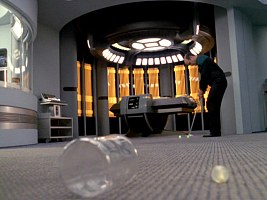
 Blinking golf balls in VOY: "Drive"
Blinking golf balls in VOY: "Drive"